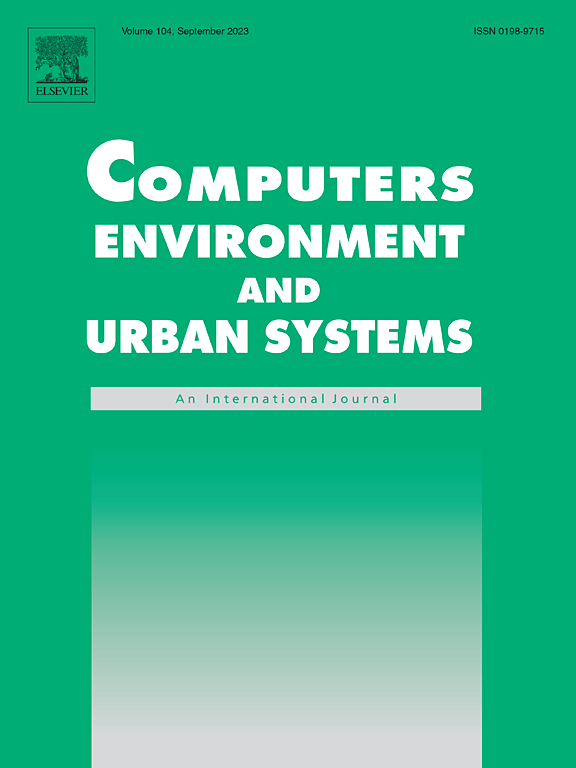Strategic bi-objective optimization for electric vehicle fleet replacement leveraging shared charging facilities
IF 8.3
1区 地球科学
Q1 ENVIRONMENTAL STUDIES
Computers Environment and Urban Systems
Pub Date : 2025-09-18
DOI:10.1016/j.compenvurbsys.2025.102353
引用次数: 0
Abstract
Electrification of vehicle fleets has advanced significantly in recent years to achieve net-zero greenhouse gas (GHG) emissions. As a cost-effective strategy, shared charging facilities are increasingly used by public and private sectors. For example, the unoccupied time of a bus charging station can be leveraged to charge other electric vehicles (EVs). This shared usage model presents both opportunities and challenges for organizations considering transitions to electrified mobility. It is especially difficult when considering the variability in daily fleet operations and the availability of charging infrastructures. This paper presents a bi-objective optimization model designed to strategically guide the replacement of vehicle fleets with EV. The model aligns the spatial-temporal dynamics of vehicle routes with the availability of shared charging facilities. It is particularly relevant for organizations managing vehicle fleets that are considering a strategic transition to EVs, with the goals of minimizing GHG emissions from fuel consumption and vehicle idling, and reducing operational delays (e.g. detour and charging time for the EV fleet). We applied this model to the University of Utah campus fleet, utilizing shared charging facilities operated by the Utah Transit Authority. The results demonstrate effective strategies for replacing vehicles with varied operational characteristics, offering detailed plans and schedules that balance GHG emission reductions with operational efficiency. Additionally, we conducted a sensitivity analysis to assess the effects of different battery sizes, station disruptions, and traffic delays on the model's outcomes and a feasibility analysis to prioritize the replacement of high-utility vehicles. Our research provides a foundation for fleet agencies to develop strategic EV replacement plans that consider multiple goals and leverage shared charging infrastructure, ultimately leading to optimized charging facility utilization and reduced maintenance costs. These strategies support more efficient, reliable, and sustainable operations in urban fleet systems.
基于共享充电设施的电动汽车置换策略双目标优化
近年来,为了实现温室气体净零排放,汽车电气化取得了显著进展。作为一项具有成本效益的策略,公共和私营部门越来越多地使用共享充电设施。例如,可以利用公共汽车充电站的空闲时间为其他电动汽车充电。这种共享使用模式为考虑向电动交通转型的组织带来了机遇和挑战。当考虑到车队日常运营的可变性和充电基础设施的可用性时,这尤其困难。本文提出了一种双目标优化模型,用于对电动汽车置换进行战略指导。该模型将车辆路线的时空动态与共享充电设施的可用性保持一致。对于正在考虑向电动汽车战略转型的车队管理组织来说,这一点尤为重要,因为他们的目标是最大限度地减少燃油消耗和车辆怠速造成的温室气体排放,并减少运营延误(例如,电动汽车车队的绕行和充电时间)。我们将此模型应用于犹他大学校园车队,利用犹他交通局运营的共享充电设施。研究结果展示了更换具有不同运行特性的车辆的有效策略,提供了平衡温室气体减排与运行效率的详细计划和时间表。此外,我们还进行了敏感性分析,以评估不同电池尺寸、车站中断和交通延误对模型结果的影响,并进行了可行性分析,以优先替换高用途车辆。我们的研究为车队代理商制定战略性的电动汽车更换计划提供了基础,这些计划考虑了多个目标,并利用共享充电基础设施,最终实现充电设施利用率的优化和维护成本的降低。这些策略支持城市车队系统更高效、可靠和可持续的运营。
本文章由计算机程序翻译,如有差异,请以英文原文为准。
求助全文
约1分钟内获得全文
求助全文
来源期刊

Computers Environment and Urban Systems
Multiple-
CiteScore
13.30
自引率
7.40%
发文量
111
审稿时长
32 days
期刊介绍:
Computers, Environment and Urban Systemsis an interdisciplinary journal publishing cutting-edge and innovative computer-based research on environmental and urban systems, that privileges the geospatial perspective. The journal welcomes original high quality scholarship of a theoretical, applied or technological nature, and provides a stimulating presentation of perspectives, research developments, overviews of important new technologies and uses of major computational, information-based, and visualization innovations. Applied and theoretical contributions demonstrate the scope of computer-based analysis fostering a better understanding of environmental and urban systems, their spatial scope and their dynamics.
 求助内容:
求助内容: 应助结果提醒方式:
应助结果提醒方式:


